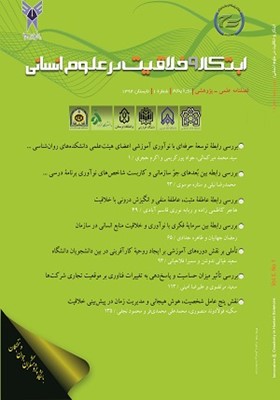بررسی تأثیر میزان حساسیت و پاسخدهی به تغییرات فناوری بر موقعیت تجاری شرکتها
محورهای موضوعی : خلاقیت و نوآوری از جنبه‏های روان‏شناختی، علوم شناختی، علوم تربیتی و آموزشی (خلاقیت شناسی روان‏شناختی، خلاقیت شناسی پرورشی)سعید مرتضوی 1 * , علیرضا امینی 2
1 - استاد گروه مدیریت دانشکده اقتصاد و علوم اداری دانشگاه فردوسی مشهد (نویسندة مسئول)mortazavi@um.ac.ir
2 - دانشجوی دکتری مدیریت رفتاری دانشگاه فردوسی مشهدa.amini@um.ac.ir
کلید واژه: حساسیت, فرصتطلبی فناوری, پاسخدهی, استراتژیهای بازاریابی,
چکیده مقاله :
زمینه: با مطالعة ارتباط بین فرصتطلبی از فناوری و موقعیت تجاری شرکت بهگونهای که به تغییرات فناوری بازار حساسیت و پاسخ مناسب و خلاق نشان داده شود و نشان دادن تأثیر مثبت و قدرتمند حساسیت و واکنش مناسب به تغییرات مبتنی بر فناوری بر معیارهای اصلی موقعیت تجاری شرکت یعنی فروش، سود و ارزش بازار و همچنین تصریح تأکید بازاریابی بهمنزلة راهبردی برای دست یابی به این ارتباط بینشهایی را برای مدیران شرکتهای صنعتی ایجاد میکند. هدف: هدف از این پژوهش بازنمایی میزان اثرگذاری حساسیت و پاسخدهی شرکتها به تغییرات حوزة فناوری بر موقعیت و موفقیت تجاری آنهاست. روش: تحقیق حاضر از نوع تحقیقات توصیفی است تا روابط بین متغیرها را بررسی کند. برای گردآوری دادهها، پرسشنامهای در بین نمونه160 نفری از کلیه فروشندگان محصولات برند سامسونگ در شهر مشهد در مناطقی توزیع شد که واحدهای صنفی بیشتری در دسترس محقق قرار داشت. برای آزمون فرضیهها نیز از معادلات ساختاری با استفاده از روش تخمین حداکثر درست نمایی استفاده شد. یافتهها: نتایج حاکی از آن است که تأکیدات استراتژیهای بازاریابی شرکت و پاسخ به تغییرات فناوری بر موقعیت تجاری شرکت سامسونگ تأثیر مثبت مستقیم دارد؛ ضمن اینکه تأکید بازاریابی شرکت عامل میانجی رابطه حساسیت نسبت به تغییرات فناوری و موقعیت تجاری شرکت سامسونگ است. نتیجه گیری: حساسیت داشتن به تغییرات فناوری و سپس پاسخدهی مناسب به آن از سوی شرکتهای بازرگانی، موفقیت آنها را در تجارت و کسبوکارشان به همراه خواهد داشت.
Purpose: This paper intended to study the relationships between the effects of the rate of sensing and responding to the technological changes on business opportunity of a corporates. Methodology: A descriptive research was used to investigate the relationship between variables under study. To collect data, a questionnaire (α= 0.821) was distributed among some 160 venders of products of SAMSUNG brand in Mashhad city. The structural equation modeling using maximum likelihood estimation was applied to test the hypotheses. Findings: The results revealed that marketing strategies of corporate and responding to technological changes had directly positive effect on business position of SAMSUNG Co. while marketing strategies plays a mediatory role on the relation between sensing to technological changes and SAMSUNG business position. Result: Sensing to technological changes and appropriate responding to it provides corporate’s prosperity in their business.
Amini, A., Darani, M., Afshani, M., & Amini, Z. (2012). Effectiveness of Marketing Strategies and Corporate Image on Brand Equity as a Sustainable Competitive Advantage. Interdisciplinary journal of contemporary research in business; 4(2): 192-205.
Arora, A., & Gambardella, A. (1990). Complementarity and external linkages: the strategies of the large firms in biotechnology. The Journal of Industrial Economics; 38, 361–379.
Benner, M. J., & Tushman, M. L. (2003). Exploitation, exploration, and process management: The productivity dilemma revisited. Academy of Management Review; 28(2), 238−256.
Capon, N., & Glazer, R. (1987). Marketing and Technology: A Strategic Co-alignment. Journal of Marketing; 51(July): 1-14.
Chandy, R. & Tellis, G. (1998). Organizing for Radical Innovation: The Overlooked Role of Willingness to Cannibalize. Journal of Marketing Research; 35: 474-487.
Day, G. S., & Schoemaker, P. J. H. (2000), Wharton on Managing Emerging Technologies. New York, NY: John-Wiley and Sons.
Katila, R., & Mang, P. Y. (2003). Exploiting technological opportunities: the timing of collaborations. Research Policy; 32: 317-332.
Kim, J-H., & Hyun, Y. J. (2011). A model to investigate the influence of marketing-mix efforts and corporate image on brand equity in the IT software sector.Industrial Marketing Management, 40, 424-438.
Mitchell, W., & Singh, K. (1996). Entrenched success: the reciprocal relationship between interfirm collaboration and business sales growth. Academy of Management Proceedings; 31–35.
Nieto, M., & Quevedo, P. (2005). Absorptive capacity, technological opportunity, knowledge spillovers, and innovative effort. Technovation; 25: 1141–1157.
Sarkees, M. (2011). Understanding the links between technological opportunism, marketing emphasis and firm performance: Implications for B2B. Industrial Marketing Management; 40: 785–795.
Scott Poole, M., & Van de Ven, A. H. (2004). Handbook of Organizational Change and Innovation. New York: Oxford University Press, Inc.
Shane, S., & Venkataraman, S. (2000). The promise of entrepreneurship as a field of research. Academy of Management Review; 25, 217–226.
Srinivasan, R. (2008). Sources, characteristics and effects of emerging technologies: Research opportunities in innovation. Industrial Marketing Management; 37: 633–640.
Srinivasan, R., Lilien, G. L., & Rangaswamy, A. (2002). Technological Opportunism and Radical Technology Adoption: An Application to E-Business. Journal of Marketing; 66(3): 47-60.
Srinivasan, S., Pauwels, K., Silva-Risso, J., & Hanssens, D. M. (2009). Product innovations, advertising, and stock returns. Journal of Marketing; 73(1): 24−43.
Stern, N., McKee, D., & Rose, G. M. (2007). Developing the organization's sense making capability: Precursor to an adaptive strategic marketing response. Industrial Marketing Management, 36(6), 731−744.
Teece, D. J., Pisano, G., & Shuen, A. (1997). Dynamic Capabilities and Strategic Management. Strategic Management Journal; 18(7): 509-533.
Wathne, K. H., & Heide, J. B. (2000). Opportunism in Inter-firm relationships: Forms, Outcomes, and Solutions. Journal of Marketing; 64(October): 36-51.
Yadav, M. S., Prabhu, J. C., & Chandy, R. K. (2007). Managing the future: CEO attention and innovation outcomes. Journal of Marketing; 71(4): 84−101.

